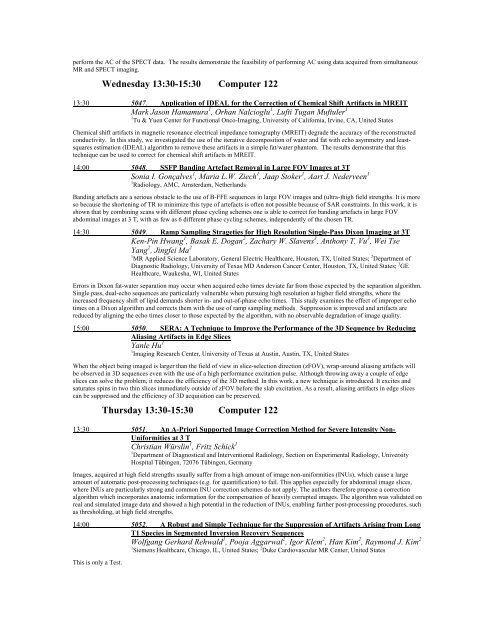ELECTRONIC POSTER - ismrm
ELECTRONIC POSTER - ismrm
ELECTRONIC POSTER - ismrm
You also want an ePaper? Increase the reach of your titles
YUMPU automatically turns print PDFs into web optimized ePapers that Google loves.
perform the AC of the SPECT data. The results demonstrate the feasibility of performing AC using data acquired from simultaneous<br />
MR and SPECT imaging.<br />
Wednesday 13:30-15:30 Computer 122<br />
13:30 5047. Application of IDEAL for the Correction of Chemical Shift Artifacts in MREIT<br />
Mark Jason Hamamura 1 , Orhan Nalcioglu 1 , Lufti Tugan Muftuler 1<br />
1 Tu & Yuen Center for Functional Onco-Imaging, University of California, Irvine, CA, United States<br />
Chemical shift artifacts in magnetic resonance electrical impedance tomography (MREIT) degrade the accuracy of the reconstructed<br />
conductivity. In this study, we investigated the use of the iterative decomposition of water and fat with echo asymmetry and leastsquares<br />
estimation (IDEAL) algorithm to remove these artifacts in a simple fat/water phantom. The results demonstrate that this<br />
technique can be used to correct for chemical shift artifacts in MREIT.<br />
14:00 5048. SSFP Banding Artefact Removal in Large FOV Images at 3T<br />
Sonia I. Gonçalves 1 , Maria L.W. Ziech 1 , Jaap Stoker 1 , Aart J. Nederveen 1<br />
1 Radiology, AMC, Amsterdam, Netherlands<br />
Banding artefacts are a serious obstacle to the use of B-FFE sequences in large FOV images and (ultra-)high field strengths. It is more<br />
so because the shortening of TR to minimize this type of artefacts is often not possible because of SAR constraints. In this work, it is<br />
shown that by combining scans with different phase cycling schemes one is able to correct for banding artefacts in large FOV<br />
abdominal images at 3 T, with as few as 6 different phase cycling schemes, independently of the chosen TR.<br />
14:30 5049. Ramp Sampling Strageties for High Resolution Single-Pass Dixon Imaging at 3T<br />
Ken-Pin Hwang 1 , Basak E. Dogan 2 , Zachary W. Slavens 3 , Anthony T. Vu 3 , Wei Tse<br />
Yang 2 , Jingfei Ma 2<br />
1 MR Applied Science Laboratory, General Electric Healthcare, Houston, TX, United States; 2 Department of<br />
Diagnostic Radiology, University of Texas MD Anderson Cancer Center, Houston, TX, United States; 3 GE<br />
Healthcare, Waukesha, WI, United States<br />
Errors in Dixon fat-water separation may occur when acquired echo times deviate far from those expected by the separation algorithm.<br />
Single pass, dual-echo sequences are particularly vulnerable when pursuing high resolution at higher field strengths, where the<br />
increased frequency shift of lipid demands shorter in- and out-of-phase echo times. This study examines the effect of improper echo<br />
times on a Dixon algorithm and corrects them with the use of ramp sampling methods. Suppression is improved and artifacts are<br />
reduced by aligning the echo times closer to those expected by the algorithm, with no observable degradation of image quality.<br />
15:00 5050. SERA: A Technique to Improve the Performance of the 3D Sequence by Reducing<br />
Aliasing Artifacts in Edge Slices<br />
Yanle Hu 1<br />
1 Imaging Research Center, University of Texas at Austin, Austin, TX, United States<br />
When the object being imaged is larger than the field of view in slice-selection direction (zFOV), wrap-around aliasing artifacts will<br />
be observed in 3D sequences even with the use of a high performance excitation pulse. Although throwing away a couple of edge<br />
slices can solve the problem, it reduces the efficiency of the 3D method. In this work, a new technique is introduced. It excites and<br />
saturates spins in two thin slices immediately outside of zFOV before the slab excitation. As a result, aliasing artifacts in edge slices<br />
can be suppressed and the efficiency of 3D acquisition can be preserved.<br />
Thursday 13:30-15:30 Computer 122<br />
13:30 5051. An A-Priori Supported Image Correction Method for Severe Intensity Non-<br />
Uniformities at 3 T<br />
Christian Würslin 1 , Fritz Schick 1<br />
1 Department of Diagnostical and Interventional Radiology, Section on Experimental Radiology, University<br />
Hospital Tübingen, 72076 Tübingen, Germany<br />
Images, acquired at high field strengths usually suffer from a high amount of image non-uniformities (INUs), which cause a large<br />
amount of automatic post-processing techniques (e.g. for quantification) to fail. This applies especially for abdominal image slices,<br />
where INUs are particularly strong and common INU correction schemes do not apply. The authors therefore propose a correction<br />
algorithm which incorporates anatomic information for the compensation of heavily corrupted images. The algorithm was validated on<br />
real and simulated image data and showed a high potential in the reduction of INUs, enabling further post-processing procedures, such<br />
as thresholding, at high field strengths.<br />
14:00 5052. A Robust and Simple Technique for the Suppression of Artifacts Arising from Long<br />
T1 Species in Segmented Inversion Recovery Sequences<br />
Wolfgang Gerhard Rehwald 1 , Pooja Aggarwal 2 , Igor Klem 2 , Han Kim 2 , Raymond J. Kim 2<br />
1 Siemens Healthcare, Chicago, IL, United States; 2 Duke Cardiovascular MR Center, United States<br />
This is only a Test.
















